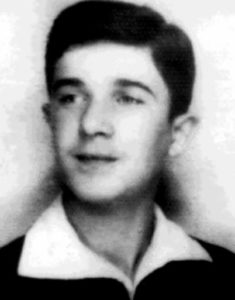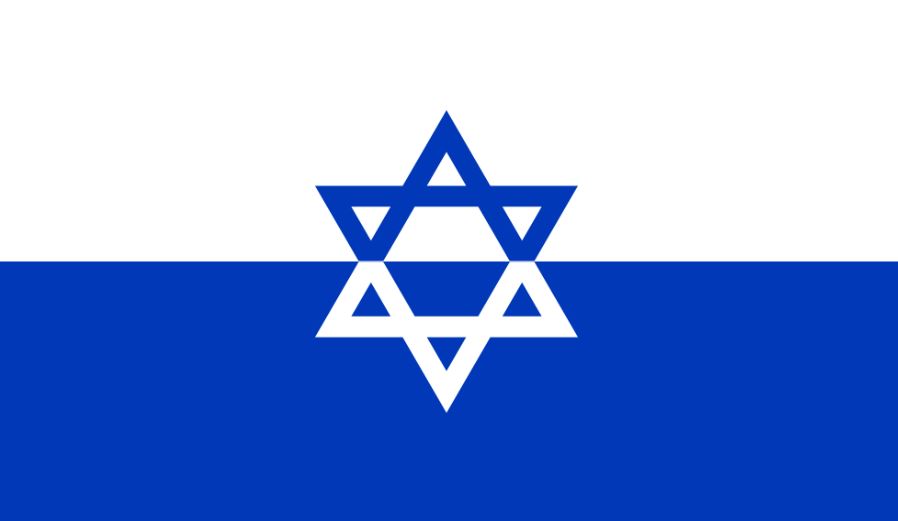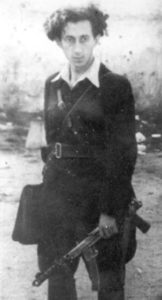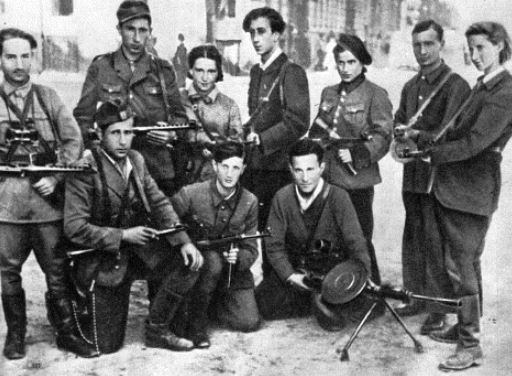Commander of the Warsaw Ghetto Uprising

Mordechai Anielewicz, commander of the Jewish Combat Organization
Mordechai Anielewicz (1919-1943) was born near Warsaw to a traditional Polish-Jewish family. After completing Hebrew school, he joined the Betar Zionist youth movement, and later Hashomer Hatzair Zionist youth movement. Shortly before the outbreak of World War II, Anielewicz participated in a Polish military training camp. When Germany invaded Poland, he joined a group of youths who fled east in the hopes of organizing an armed resistance. However, the Soviets invaded the eastern half of Poland, and Anielewicz was eventually arrested and thrown in jail for helping Jewish refugees flee across Romania to Israel. Released from prison shortly after, Anielewicz returned to Warsaw and began organizing a resistance movement. He started a secret newspaper called Neged HaZerem, “Against the Current”. By the end of 1940, Anielewicz was among 400,000 Jews (a third of Warsaw’s total population) forcibly crammed and imprisoned inside the tiny Warsaw Ghetto. Less than a year later, the Nazis started “evacuating” Jews from the Ghetto and when Anielewicz heard reports of mass murder, he called up his resistance fighters. The group attempted to join the Polish underground resistance, but was rebuffed. They risked their lives trying to smuggle and build up a weapons arsenal inside the Ghetto. By September 1942, three quarters of the Warsaw Ghetto’s Jews were deported, and 265,000 of them murdered. Anielewicz and his team started building bunkers and tunnels, and stockpiling their homemade grenades and Molotov cocktails. Shortly after, they were able to acquire several rifles and mines, and one machine gun from the Polish underground. They staged their first attack in January of 1943, and managed to free a handful of Jews. This convinced the Polish underground that the Jews could fight, and they smuggled more weapons to the group (with help from the Jewish Military Union, made up of former officers in the Polish army) now calling itself the Jewish Combat Organization. The resistance continued to make serious trouble for the Nazis. When word came that the Warsaw Ghetto would soon be liquidated, Anielewicz wrote a letter to all of its residents to join the fight, writing that “We are slaves, and when slaves are no longer profitable, they are killed.” The Nazis began the final deportation on April 19, the morning before Passover. They sent in 821 SS troops, who were met by 750 Jewish fighters under the command of Anielewicz. The Jews inflicted serious damage, and the Nazis retreated. They returned with over 2000 soldiers and heavier weapons. The Jewish resistance had the upper hand for nearly a week – and at one point even raised up their flag – but were eventually overpowered. More than 56,000 Jews were captured. The Nazis continued to search for bunkers and slaughter anyone hiding inside. They reached the command bunk on Mila Street on May 7th, where nearly three hundred Jews, including Anielewicz, were shot to death, died by suffocation from gas grenades, or committed suicide. The surviving fighters continued to resist until May 16. While the vast majority of Jews perished, a handful of survivors known as the “Ghetto Fighters” later settled in Israel and established a kibbutz. The actions of Anielewicz gave Jews a sense of hope and strength. He inspired countless others both in his day, and in the present day, and became a symbol of bravery and self-sacrifice. The Polish Army posthumously awarded Anielewicz the Cross of Valour and the Cross of Grunwald. This year, the eve of Passover is once again on April 19, as it was in 1943 when Anielewicz and his courageous warriors launched the Warsaw Ghetto Uprising.
11 Common Passover Misconceptions
Words of the Week
Regarding the custom of opening the door for Eliyahu on Passover night – don’t think Eliyahu really enters through the physical door of your house. Instead he enters through the doors of your heart and mind.
– Rabbi Menachem Mendel of Kotzk, the Kotzker Rebbe

Flag of the Jewish Combat Organization Flag

 Abel “Abba” Kovner (1918-1987) was born in what is today Belarus and grew up in Vilnius (then part of Poland). As a young man, he was a member of HaShomer HaTzair, the Zionist youth movement. When the Nazis invaded Vilnius in 1941, Kovner escaped to a convent, but soon returned to the Vilna Ghetto to organize a Jewish resistance. At the start of 1942, Kovner secretly published a manifesto inside the Ghetto to inspire the Jews to fight back, writing that it was better to die than “go like lambs to the slaughter”. Along with several other young men, Kovner formed the United Partisan Organization, possibly the first armed underground Jewish group in Nazi Europe. Before they could launch their first large-scale attack, the Vilna Ghetto was liquidated in 1943, forcing the group to flee to the surrounding forests. From there, they launched a guerrilla warfare campaign against the Nazis. The small group began calling themselves “the Avengers” (HaNokmim) and were successful enough to draw the attention of the Red Army. They would go on to coordinate with the Soviets to crush the Nazis in Eastern Europe. Once the fate of the Nazis was sealed towards the end of 1944, Kovner was among the founders of a new group, called Bricha (“Escape”), which worked to get Jewish refugees out of Europe and to the Holy Land. Over the next couple of years, they would successfully move 250,000 Holocaust survivors to Israel. Having seen first-hand the horrific devastation inflicted by the Nazis, Kovner yearned for revenge. He started yet another group, called Nakam (“Vengeance”), seeking to punish Germany for the Holocaust. “Plan B” was to poison the water supply in Allied prisoner-of-war camps where Nazi SS soldiers were kept. The far more controversial and shocking “Plan A” was to poison the water supplies of several major German cities in order to kill 6 million Germans, one for each Jew lost in the Holocaust. Thankfully, Plan A was soon abandoned, though Kovner was still arrested by the British and held in a Cairo prison for several months. He did aim to accomplish Plan B, and Nakam members infiltrated a POW camp bakery in April 1946, coating the loaves of bread with arsenic. Over two thousands German soldiers fell ill, though no deaths were reported. In December 1947, Kovner joined the Haganah and fought in Israel’s Independence War as a captain of the Givati Brigade. Following this, he lived out the remainder of his life in a kibbutz, working tirelessly to strengthen the nascent state. He also helped to design several Holocaust museums, and testified at the Eichmann trial. More famously, Kovner wrote a series of poetry books (in Hebrew and Yiddish) describing the struggles he faced during the Holocaust and in Israel’s early years. This made him one of the country’s most celebrated poets and writers. For this, he won the Israeli Prize for Literature in 1970. A heavy smoker, Kovner succumbed to tracheal cancer before his 70th birthday.
Abel “Abba” Kovner (1918-1987) was born in what is today Belarus and grew up in Vilnius (then part of Poland). As a young man, he was a member of HaShomer HaTzair, the Zionist youth movement. When the Nazis invaded Vilnius in 1941, Kovner escaped to a convent, but soon returned to the Vilna Ghetto to organize a Jewish resistance. At the start of 1942, Kovner secretly published a manifesto inside the Ghetto to inspire the Jews to fight back, writing that it was better to die than “go like lambs to the slaughter”. Along with several other young men, Kovner formed the United Partisan Organization, possibly the first armed underground Jewish group in Nazi Europe. Before they could launch their first large-scale attack, the Vilna Ghetto was liquidated in 1943, forcing the group to flee to the surrounding forests. From there, they launched a guerrilla warfare campaign against the Nazis. The small group began calling themselves “the Avengers” (HaNokmim) and were successful enough to draw the attention of the Red Army. They would go on to coordinate with the Soviets to crush the Nazis in Eastern Europe. Once the fate of the Nazis was sealed towards the end of 1944, Kovner was among the founders of a new group, called Bricha (“Escape”), which worked to get Jewish refugees out of Europe and to the Holy Land. Over the next couple of years, they would successfully move 250,000 Holocaust survivors to Israel. Having seen first-hand the horrific devastation inflicted by the Nazis, Kovner yearned for revenge. He started yet another group, called Nakam (“Vengeance”), seeking to punish Germany for the Holocaust. “Plan B” was to poison the water supply in Allied prisoner-of-war camps where Nazi SS soldiers were kept. The far more controversial and shocking “Plan A” was to poison the water supplies of several major German cities in order to kill 6 million Germans, one for each Jew lost in the Holocaust. Thankfully, Plan A was soon abandoned, though Kovner was still arrested by the British and held in a Cairo prison for several months. He did aim to accomplish Plan B, and Nakam members infiltrated a POW camp bakery in April 1946, coating the loaves of bread with arsenic. Over two thousands German soldiers fell ill, though no deaths were reported. In December 1947, Kovner joined the Haganah and fought in Israel’s Independence War as a captain of the Givati Brigade. Following this, he lived out the remainder of his life in a kibbutz, working tirelessly to strengthen the nascent state. He also helped to design several Holocaust museums, and testified at the Eichmann trial. More famously, Kovner wrote a series of poetry books (in Hebrew and Yiddish) describing the struggles he faced during the Holocaust and in Israel’s early years. This made him one of the country’s most celebrated poets and writers. For this, he won the Israeli Prize for Literature in 1970. A heavy smoker, Kovner succumbed to tracheal cancer before his 70th birthday.